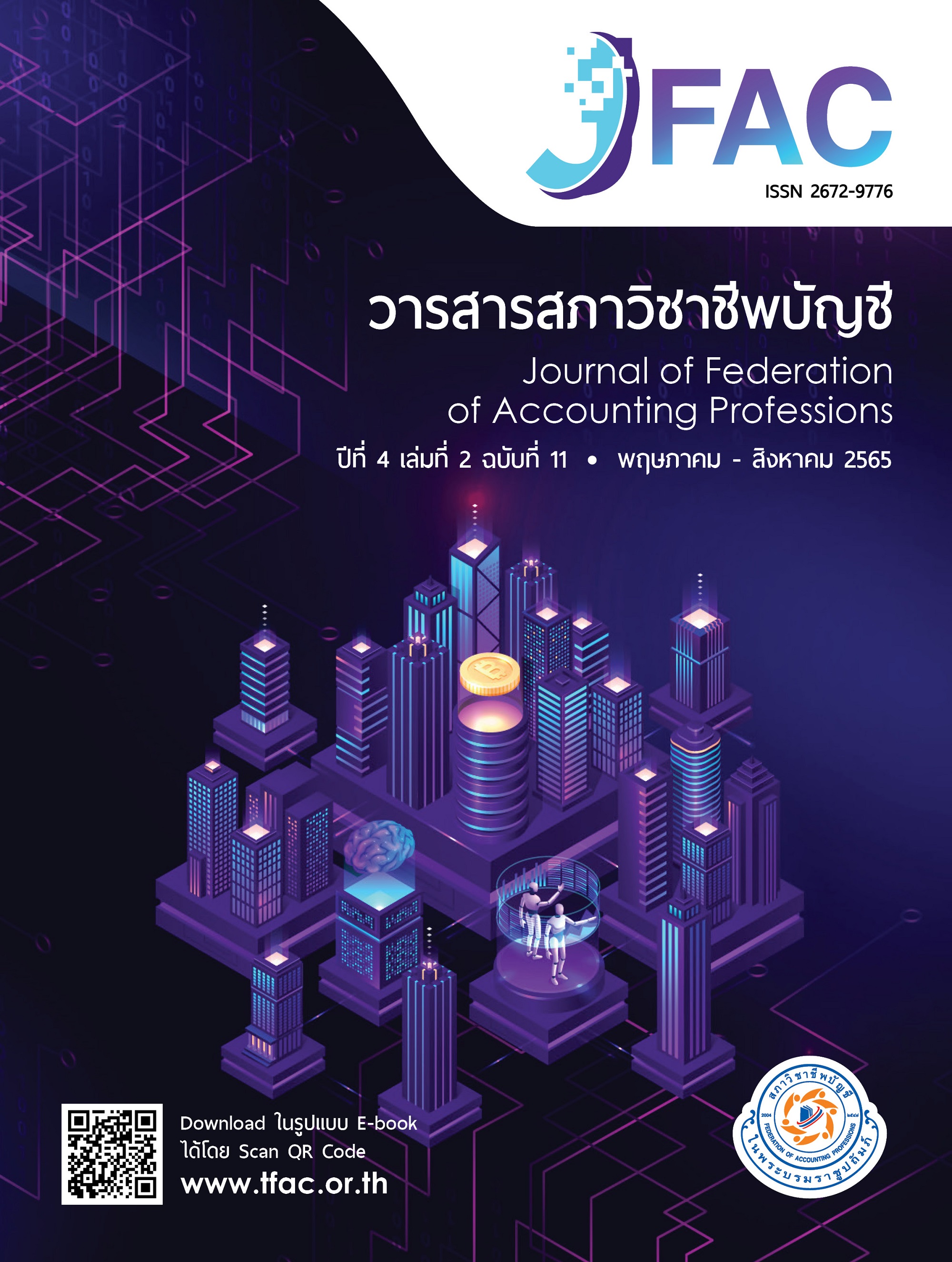กำไรหรือขาดทุนจากการเปลี่ยนแปลงมูลค่ายุติธรรมของสินทรัพย์ทางการเงิน ในการอธิบายกำไรในอนาคตของบริษัทจดทะเบียนไทย กลุ่มธุรกิจการเงิน
Main Article Content
บทคัดย่อ
งานวิจัยนี้ศึกษาถึงความสามารถในการอธิบายกำไรอนาคตของกำไรปีปัจจุบัน และข้อมูลจากการเปลี่ยนแปลงมูลค่ายุติธรรมของสินทรัพย์ทางการเงินปีปัจจุบัน ของบริษัทจดทะเบียนในตลาดหลักทรัพย์แห่งประเทศไทย กลุ่มธุรกิจการเงิน โดยใช้ข้อมูลตั้งแต่ปี 2555 ถึงปี 2562 หลังจากนำบริษัทที่มีข้อมูลไม่สมบูรณ์ออกไป กลุ่มตัวอย่างสุดท้ายประกอบด้วย 222 ชุด และ 179 ชุด สำหรับการทดสอบการอธิบายกำไรปีถัดไป 1 ปี และ 2 ปี ตามลำดับ
ผลการวิจัยพบว่า กำไรปีปัจจุบันและรายการกำไรหรือขาดทุนจากการเปลี่ยนแปลงมูลค่ายุติธรรมของหลักทรัพย์เผื่อขายปีปัจจุบัน มีความสามารถในการอธิบายกำไรอนาคตถัดไป 1 ปี และ 2 ปี อย่างไรก็ตาม ผลของการวิเคราะห์ทางสถิติพบว่า ความสามารถในการอธิบายกำไรอนาคตถัดไป 1 ปีดีกว่า 2 ปี เมื่อเปรียบเทียบแบบจำลองที่ประกอบด้วยกำไรปีปัจจุบันเท่านั้น กับแบบจำลองที่ประกอบด้วยกำไรปีปัจจุบันและรายการกำไรหรือขาดทุนจากการเปลี่ยนแปลงมูลค่ายุติธรรมของหลักทรัพย์เผื่อขายปีปัจจุบันพบว่า แบบจำลองที่รวมรายการกำไรหรือขาดทุนจากการเปลี่ยนแปลงมูลค่ายุติธรรมของหลักทรัพย์เผื่อขายปีปัจจุบันสามารถอธิบายกำไรอนาคตได้สูงกว่า นอกจากนี้ ยังพบว่าแบบจำลองที่เพิ่มขนาดของกิจการปีปัจจุบันซึ่งเป็นตัวแปรควบคุมมีความสามารถในการอธิบายกำไรอนาคตเพิ่มขึ้น
Article Details
เนื้อหาและข้อมูลในบทความที่ลงตีพิมพ์ในวารสารสภาวิชาชีพบัญชี ถือเป็นข้อคิดเห็นและความรับผิดชอบของผู้เขียนบทความโดยตรงซึ่งกองบรรณาธิการวารสารไม่จำเป็นต้องเห็นด้วยหรือร่วมรับผิดชอบใด ๆ
บทความ ข้อมูล เนื้อหา รูปภาพ ฯลฯ ที่ได้รับการตีพิมพ์ในวารสารสภาวิชาชีพบัญชี ถือเป็นลิขสิทธิ์ของวารสารสภาวิชาชีพบัญชี หากบุคคลหรือหน่วยงานใดต้องการนำข้อมูลทั้งหมดหรือบางส่วนไปเผยแพร่ต่อหรือเพื่อกระทำการใดๆ จะต้องได้รับอนุญาตเป็นลายลักษณ์อักษรจากวารสารสภาวิชาชีพบัญชี ก่อนเท่านั้น
เอกสารอ้างอิง
Argilés, J. M., Garcia-Blandon J., & Monllau, T. (2011). Fair value versus historical cost-based
valuation for biological assets: predictability of financial information. Spanish Accounting Review, 14(2), 87-113.
Bandyopadhyay, S. P., Chen, C. & Wolfe, M. (2017). The predictive ability of investment
property fair value adjustments under IFRS and the role of accounting conservatism. Advances in Accounting, 38, 1-14.
Barth, M. E. (1994). Fair value accounting: Evidence from investment securities and the
market valuation of banks. The Accounting Review, 69(1), 1-25.
Barth, M. E., Beaver, W. H., & Landsman, W. R. (1997). Are banks' SFAS no. 107 fair-value
disclosures relevant to investors?. Bank Accounting & Finance, 10(4), 9-15.
Bordeelertrit, P. (2018). Equity valuation and fair value accounting. Journal of Accounting
Profession, 14(41), 39-62.
Bratten, B., Causholli, M., & Khan, U. (2016). Usefulness of fair values for predicting banks'
future earnings: Evidence from other comprehensive income and its components. Review of Accounting Studies, 21(1), 280-315.
Cao, T., Donnelly, R., & Shaari, H. (2013). Fair value and value in use: An improvement over
Historical cost?. Accountancy Ireland, 45(3), 59-61.
Chae, C. I., Choi, A., & Yim, S. (2016). Fair value accounting and financial stability - based on
the adoption. Journal of Applied Business Research, 32(6), 1825-1842.
Chakraborty, T. (2010). The relationship between fair values in banks' trading books and
volatility in share price returns in the Indian context. IUP Journal of Accounting Research & Audit Practices, 9(1), 63-83.
Dechow, P. M. (1994). Accounting earnings and cash flows as measures of firm performance:
The role of accounting accruals. Journal of Accounting and Economics, 18 (1), 3-42.
Ehalaiye, D., Tippett, M., & Zijl T. (2017). The predictive value of bank fair values.
Pacific-Basin Finance Journal, 41, 111-127.
Elbannan, M A. & Elbannan, M A. (2015). Information content of SFAS 157 fair value reporting,
Journal of International Accounting, Auditing and Taxation, 25, 31-45.
Evans, M. E., Hodder, L., & Hopkins, P. E. (2014). The predictive ability of fair values for future
financial performance of commercial banks and the relation of predictive ability to banks' share prices. Contemporary Accounting Research, 31(1), 13-44.
Federation of Accounting Professions of Thailand (2015). Conceptual Framework for Financial
Reporting (revised 2015) Retrieved from https://acpro-std.tfac.or.th/uploads/files/NOxoIsj0qL.pdf
Federation of Accounting Professions of Thailand (2019). Thai Financial Reporting Standard
(revised 2019): Fair Value Measurement. Retrieved from https://acpro-std.tfac.or.th/page/27/ TFRS_13_revised_2562%20(3).pdf
Finger, C. A. (1994). The ability of earnings to predict future earnings and cash flow. Journal
of Accounting Research, 32(2), 210-223.
Hsu A. W.-H., Wu G. S.-H., & Sbaraglia, A. (2020). Predicting future performance using fair value
Versus historical cost: Evidence from investment property. NTU Management Review, 30(2), 311-334.
Junsangeam, D. & Srijunpetch, S. (2015). The effect of fair value hierarchy disclosure from
different performance on nonprofessional investors’ judgments. Journal of Accounting Profession, 11(31), 80-90.
Kathy, R. P., & Wahlen, J. M. (1995). Fair values of equity and debt securities and share prices
of property- liability insurers. Journal of Risk and Insurance (1986-1998), 62(4), 719-737.
Landsman, W. R. (2007). Is fair value accounting information relevant and reliable? evidence
from capital market research. Accounting and Business Research, 37(3), 19-30.
Laux, C. & Leuz, C. (2009), The crisis of fair-value accounting: Making sense of the recent
debate. Accounting. Organizations and Society, 34(6-7), 826-834.
Lu, H.-Y. & Mande, V. (2014). Does disaggregation of fair value information increase the value
relevance of the fair value hierarchy?, Research in Accounting Regulation, 26(1), 90-97.
Magnan, M., Menini, A., & Parbonetti, A. (2015). Fair value accounting: Information or
confusion for financial markets? Review of Accounting Studies, 20(1), 559-591.
Palea, V. (2014). Fair value accounting and its usefulness to financial statement users.
Journal of Financial Reporting and Accounting, 12(2), 102-116.
Rhee, C. S., Choi, E. S., & Ryu, J. Y. (2018). The influence of firm’s fair value system on
earnings quality under IFRS. Journal of Applied Business Research, 34(3), 427-436.
Šodan, S. (2015). The Impact of fair value accounting on earnings quality in eastern
european countries, Procedia Economics and Finance, 32, 1769-1786.
Srijunpetch, S. (2016). Auditor and fair value auditing. Journal of Business Administration,
(2), 9-15.


